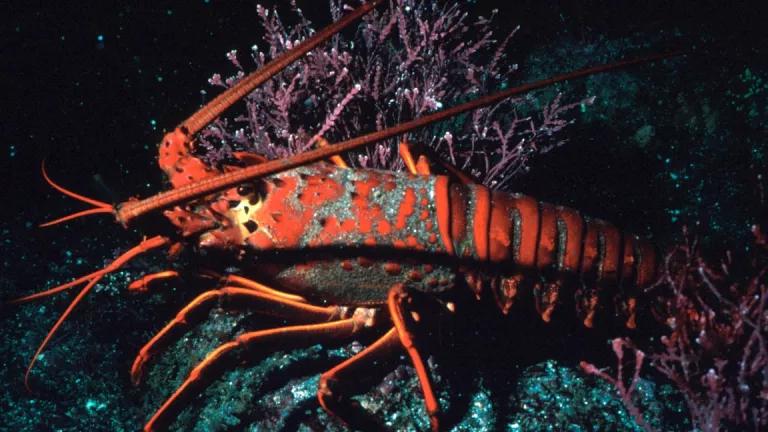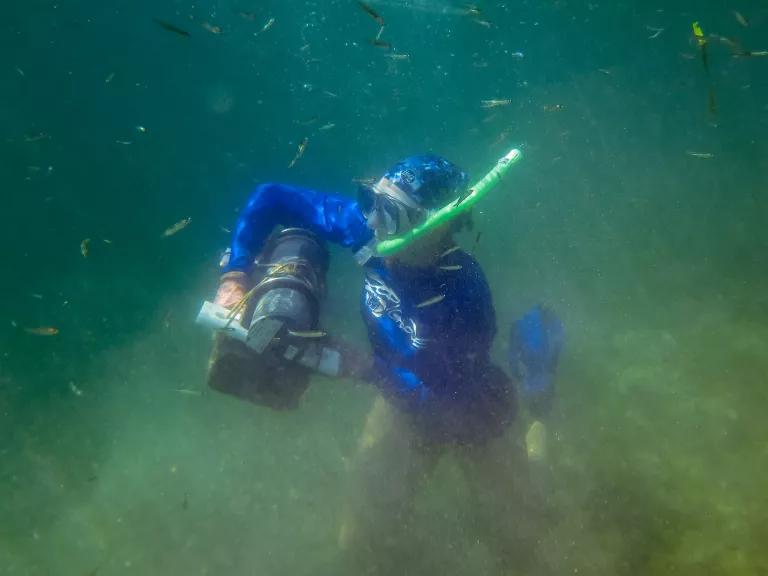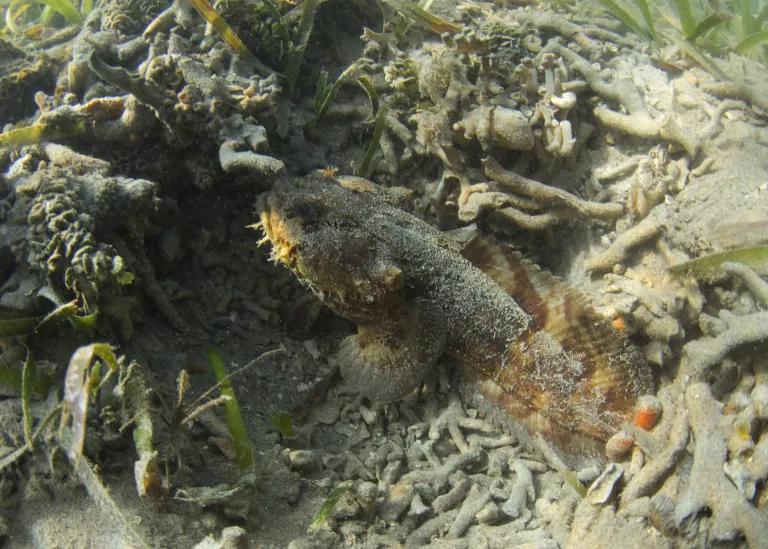Bugging the Ocean
Eavesdropping on the sea reveals the surprising chattiness of fish and invertebrates.

Ah, the noises made by creatures of the ocean.
Crackle crackle crackle.
Grrrrrr.
Knock knock.
What, were you expecting the haunting songs of whales or the cheerful chirping of dolphins? Sure, the noises those charismatic mammals make have long been studied (and these days, land-dwelling insomniacs can choose from dozens of cetacean song apps to help them drift off to dreamland). But there are many more sounds in the sea.
“Almost everything in the ocean uses sound in some way,” says Erica Staaterman, an acoustic ecologist. Staaterman investigates the noises made by less studied, less sexy aquatic organisms. “Unlike the more harmonic sounds made by marine mammals, fish and invertebrates are trickier because their sounds are thumpy and growly and knocky.”
That doesn’t make them any less valuable or important to document and understand. Listening to the hubbub of coral reefs or oyster beds might one day prove to be a no-fuss, noninvasive way to assess the health of those ecosystems. And anthropogenic din, from boats to sonar, is unlikely to take a toll only on mammals like whales, dolphins, and seals; it probably stresses the smaller creatures, those closer to the base of the food web, too.
Staaterman is a member of a small cadre of scientists devoted to expanding our knowledge of the sounds that fish and invertebrates make and the reasons they do so. Take spiny lobsters: Staaterman helped discover that when attacked, they jolt back their antennae to produce a startling wreeenk that just might disconcert the predator long enough for the lobster to scurry away. And she and colleagues found that mantis shrimp—known for their powerful punch—join together in a rumbling chorus at dawn and dusk. “It’s pretty cool because that’s what happens with birds and frogs and crickets, but we never really think about that in the ocean, especially for crustaceans,” she says.

Staaterman is currently conducting her eavesdropping as a postdoc fellow at the Smithsonian Institute’s MarineGEO program, a global effort to study coastal ecosystems. Her acoustic work will add to the data other MarineGEO researchers are gathering, from ocean acidity levels to fish counts. She splits her time between the Chesapeake Bay and the waters off the eastern coast of Panama.
Right now, Staaterman is in Panama, examining how fish respond to boat noise. For the project, she’s teamed up with her husband Austin Gallagher, a stress physiologist. (His specialty, she says, is “the most flashy possible science there is—tagging sharks.”) They’re collecting fish and forcing them to listen to the recorded sounds of boats. Later they will check the fish’s blood for higher concentrations of stress hormones, such as lactates and cortisol, to see if the noises freaked the animals out. “It’s not very fun for us to be under loud, noisy conditions,” says Staaterman. “So it’s probably similar even if you have a brain the size of the pea.”
When snorkeling in the warm, salty waters of the Caribbean, you might find it impossible to ignore the loud, deep belches of the large-eyed and aptly named toadfish that dominate the soundscape. “You can hear them when you're underwater, and they are everywhere,” says Staaterman. In addition to her stress research, she hopes to investigate how and why the fish make those toadlike noises. It could be, for instance, that males emit the croaks as a come-hither call to passing female, or use them to defend territory. Or it could be something else entirely.
When the ecologist returns to the far colder waters of Maryland in March, she’ll deploy two hydrophones below the surface for several months, one in a somewhat sheltered area in the Rhode River, and the other in the main stem of the Chesapeake River, closer to shipping channels and saltier waters where a greater diversity of aquatic life is found. Other researchers have documented—with nets and sonar—which animals are in those areas at different times of the year. The hydrophones will record the chatter of fish and invertebrates, such as crabs, as they crawl or swim on by. Staaterman will also capture some so she can record the animals in the lab. (Note: By “lab,” I mean an outbuilding at the Smithsonian Environmental Research Center that she soundproofed with foam and padding late last year.)
Simply figuring out which species make what kinds of noises is an important advance in the fledgling acoustic marine ecology arena. Although scientists may someday simply deploy hydrophones to record species diversity and the number of individual animals at a given site, that kind of specificity is still years away. But chatterboxes of the deep, beware: After long being ignored, your crackles, grrrrs, and knocks are being listened in on.

This article was originally published on onEarth, which is no longer in publication. onEarth was founded in 1979 as the Amicus Journal, an independent magazine of thought and opinion on the environment. All opinions expressed are those of the authors and do not necessarily reflect the policies or positions of NRDC. This article is available for online republication by news media outlets or nonprofits under these conditions: The writer(s) must be credited with a byline; you must note prominently that the article was originally published by NRDC.org and link to the original; the article cannot be edited (beyond simple things such grammar); you can’t resell the article in any form or grant republishing rights to other outlets; you can’t republish our material wholesale or automatically—you need to select articles individually; you can’t republish the photos or graphics on our site without specific permission; you should drop us a note to let us know when you’ve used one of our articles.

How to Become a Community Scientist
Biodiversity 101
How to Start Saving the Planet in 100 Days: the Joe Biden Edition